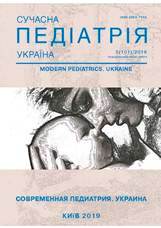The effect of metabolic therapy on carnitine status and metabolomic amino acid profile in children with chronic kidney disease
Abstract
Objective: to study the effect of metabolic therapy with levocarnitine on carnitine status, metabolomic amino acid profile and the functional state of the cardiovascular system in children with chronic kidney disease (CKD) 4–5 st.Materials and methods. The concentration of acylcarnitines and amino acids in dry blood spots was determined in 38 children with CKD 2–5 st. aged from 2 to 17 by liquid chromatography tandem mass spectrometry. To correct the carnitine status in 20 children with CKD 4–5 st., levocarnitine (Agvantar) was administered orally at the rate of 50 mg/kg daily for 2 months. The efficacy and safety of levocarnitine was evaluated based on the value dynamics of metabolomic amino acid profile, carnitine status, clinical and laboratory values, electrocardiography and echocardiography.
Results. The obtained results showed that oral administration of levocarnitine was accompanied by significant dynamics of an increase in free carnitine (C0) to the level of 46.11±2.9 μm as compared with the data obtained before treatment in patients with CKD 2–5 st. (p<0.05). After 2 months of levocarnitine therapy, the content of C5DC (glutarylcarnitine) and C6DC (3-methylglutaconylcarnitine) decreased twice in comparison with respective values obtained in patients with CKD 5 st. before treatment (p<0.05). Levocarnitine intake did not have a negative effect on the metabolomic amino acid spectrum of the blood. Over 2 months of levocarnitine therapy, improvement of the functional state of the cardiovascular system and an increase in physical endurance was achieved in children with CKD 4–5 st.
Conclusions. Prescription of levocarnitine (Agvantar) to children with CKD 4–5 st. is pathogenetically justified, it can improve the carnitine status values, restore the free carnitine pool and, in combination with complex therapy, achieve stabilization of the functional state of the cardiovascular system.
The research was carried out in accordance with the principles of the Helsinki Declaration. The study protocol was approved by the Local Ethics Committee of Kyiv City Children's Clinical Hospital No. 1. The informed consent of the patient was obtained for conducting the studies.
References
Mondoev LG, Birjukova LS. (2007). Application of carnitine in patients with the chronic renal failure, undergoing long-term hemodialysis. Nephrology and dialysis. 9(4): 391–394.
Tokarchuk NI, Vyzhga YV. (2016). Prescribtion of the levocarnitin for the treatment of secondary cardiomyopathy in infants. Sovremennaya pediatriya. 5(77): 67–70. https://doi.org/10.15574/SP.2016.77.67.
Azevedo VM, Albanesi Filho FM, Santos MA et al. (2013). The role of L-carnitine in nutritional status and echocardiographic parameters in idiopathic dilated cardiomyopathy in children. J Pediatr. 81(5): 368–372. https://doi.org/10.2223/JPED.1387; PMid:16247537
Di Liberato L, Arduini A, Rossi C et al. (2014). L-carnitine status in endstage renal disease patients on automated peritoneal dialysis. J Nephrol. 27(6): 699–706. https://doi.org/10.1007/s40620-014-0076-x; PMid:24599831
El-Hattab AW, Scaglia F. (2015). Disorders of carnitine biosynthesis and transport. Molecular Genetics and Metabolism. 116(3): 107–112. https://doi.org/10.1016/j.ymgme.2015.09.004; PMid:26385306
Fu L, Huang M, Chen S. (2013). Primary carnitine deficiency and cardiomyopathy. Korean Circulation Journal. 43(12): 785–792. https://doi.org/10.4070/kcj.2013.43.12.785; PMid:24385988 PMCid:PMC3875693
Jafari A, Khatami M-R, Dashti-Khavidaki S. et al. (2017). Protective effects of L-carnitine against delayed graft function in kidney transplant recipients: a pilot, randomized, double-blinded, placebo-controlled clinical trial. Renal Nutrition. 27(2): 113–126. https://doi.org/10.1053/j.jrn.2016.11.002; PMid:28065453
Kidney Disease: Improving Global Outcomes (KDIGO) СKD Work Group. KDIGO 2012. (2013). Clinical Practice Guideline for the Evaluation and Management of Chronic Kidney Disease. Kidney Inter Suppl. 3: 1–150.
Lundin U, Weinberger KM. (2018). Towards metabolic biomarkers for the diagnosis and prognosis of CKD. https://www.intechopen.com/books/advances-in-nephropathy-towards-metabolic-biomarkers-for-the-diagnosis-and-prognosis-of-ckd. https://doi.org/10.5772/intechopen.80335
Mercadal L, Coudert M, Vassault A et al. (2012). L-carnitine treatment in incident hemodialysis patients: the multicenter, randomized, double-blinded, placebo-controlled CARNIDIAL trial. Clin J Am Soc Nephrol. 7(11): 1836–1842. https://doi.org/10.2215/CJN.12431211; PMid:22935844 PMCid:PMC3488953
National Kidney Foundation. (2002). K/DOQI clinical practice guidelines for chronic kidney diseases: evaluation, classification and stratification. Am J Kidney Dis. 39(1): 17–31.
Sgambat K, Moudgil A. (2016). Carnitine deficiency in children receiving continuous renal replacement therapy. Hemodial Int. 20(1): 63–67. https://doi.org/10.1111/hdi.12341; PMid:26265013
Downloads
Issue
Section
License
The policy of the Journal “MODERN PEDIATRICS. UKRAINE” is compatible with the vast majority of funders' of open access and self-archiving policies. The journal provides immediate open access route being convinced that everyone – not only scientists - can benefit from research results, and publishes articles exclusively under open access distribution, with a Creative Commons Attribution-Noncommercial 4.0 international license (СС BY-NC).
Authors transfer the copyright to the Journal “MODERN PEDIATRICS. UKRAINE” when the manuscript is accepted for publication. Authors declare that this manuscript has not been published nor is under simultaneous consideration for publication elsewhere. After publication, the articles become freely available on-line to the public.
Readers have the right to use, distribute, and reproduce articles in any medium, provided the articles and the journal are properly cited.
The use of published materials for commercial purposes is strongly prohibited.

